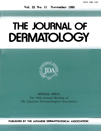The Epidemiology of Non-Melanoma Skin Cancer: Who, Why and What Can We Do about It
Abstract
Non-melanoma skin cancer (NMSC) comprised of basal cell carcinoma (BCC) and squamous cell carcinoma (SCC) are the most common cancers in humans in many countries. Sunlight plays a major part in the development of these tumours which appear predominantly on areas of the most frequently exposed skin.
The site distribution for BCC and SCC is not the same, with SCC being most common on the sites of very heavy exposure and BCC becoming more common on areas of only moderate exposure, e.g. upper trunk in men and women and lower leg in women.
Incidence rates of NMSC, where they are being recorded, show rises over time. Mortality rates, on the other hand, have been dropping most of this century until they have been levelling out recently. The case fatality rate due to SCC appears to be between 1–2%. The malignant transformation rate of actinic keratoses to SCC appears to be very low.
Studies on similar populations at different latitudes allow estimates to be made of increases which might occur with increasing exposure to ultraviolet radiation (UVR) over a life time. These have been used to estimate the possible increases in NMSC due to stratospheric ozone depletion.
Finally, recent studies on the reduction of existing actinic keratoses and prevention of new ones with regular use of sunscreen augurs well for prevention of NMSC in the future.




